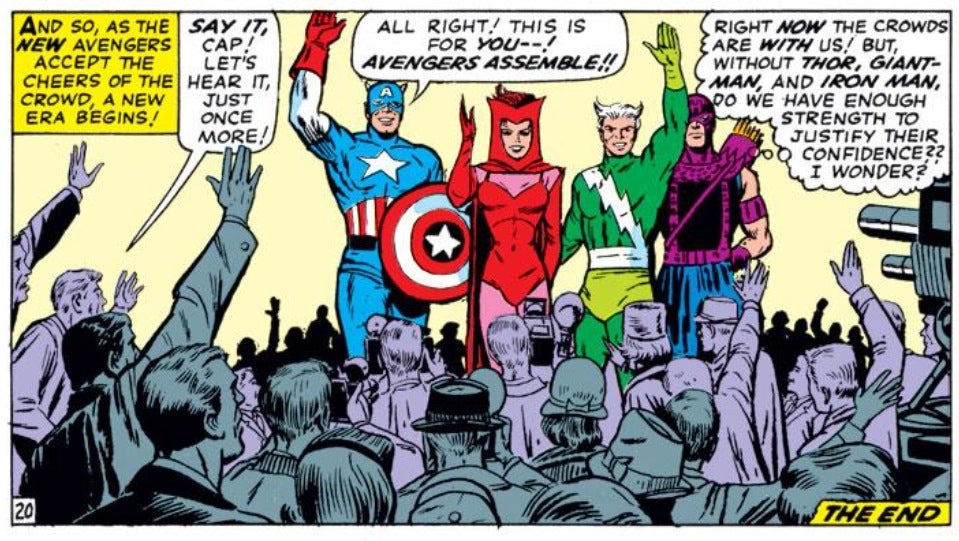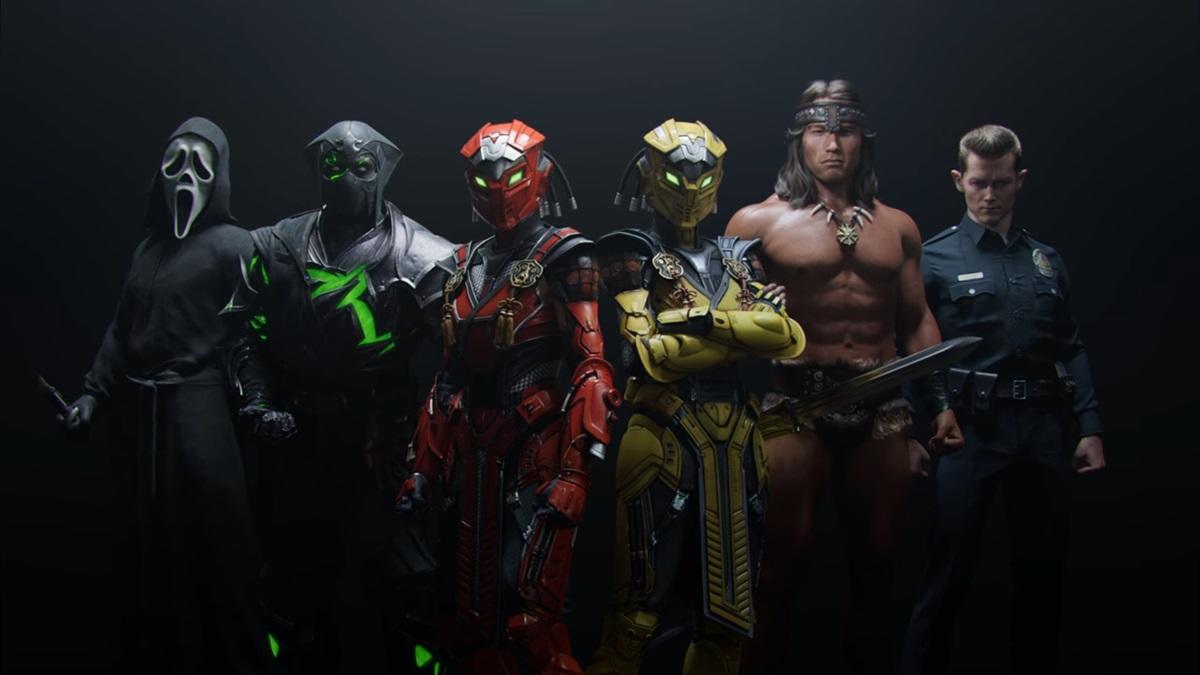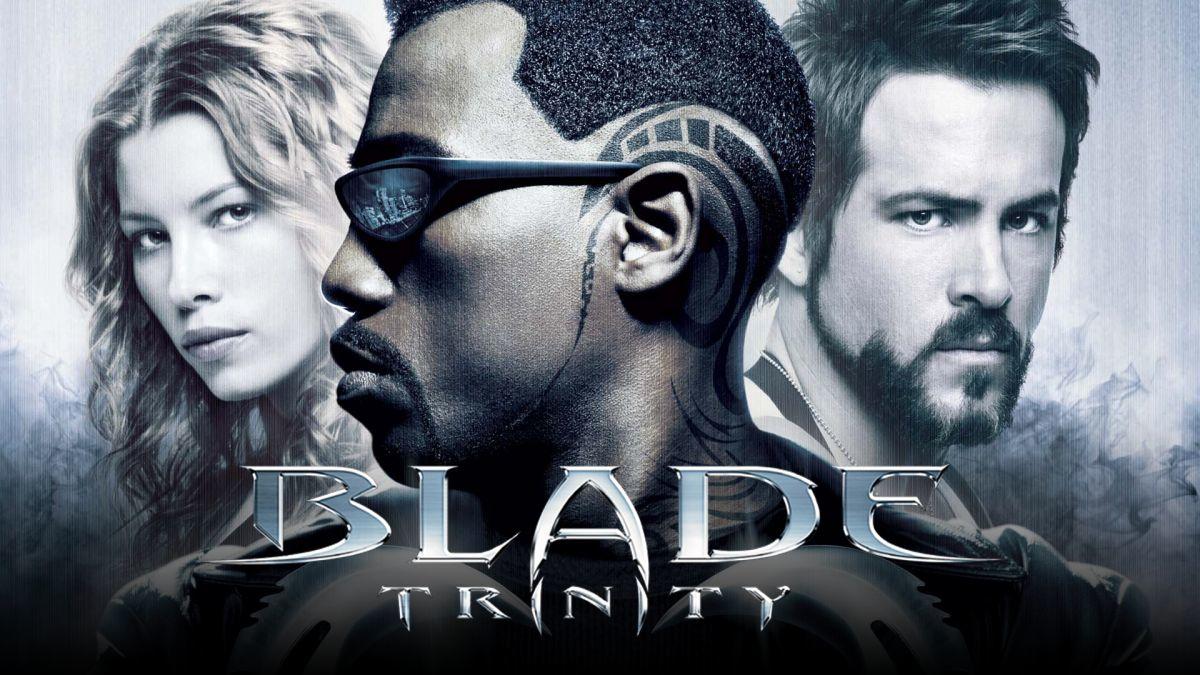75 Most Iconic Marvel Comics Moments: #45-31
ComicBook.com's countdown of the 75 most iconic moments in Marvel Comics history continues with [...]

ComicBook.com's countdown of the 75 most iconic moments in Marvel Comics history continues with this next batch of 15 entries. Click here for part one of the list (moments #75-61) and click here for part two (moments #60-46).
Let's get right into moments #45-31:

45. Cap's Kooky Quartet
From: Avengers #16 (May, 1965)
Only a year-and-change into the Avengers series, "Earth's Mightiest Heroes" experienced a major roster shake-up when Thor, Iron Man, Hank Pym and Wasp all left the team and Hawkeye, Quicksilver and Scarlet Witch joined Captain America. The debut of "Cap's Kooky Quartet," as they were dubbed, demonstrated an ongoing trope that still applies to the Avengers today – that the group should always be flexible and adaptable in terms of accepting new members and allowing the old guard to move on. Or as Iron Man said, "The ranks of the Avengers will always need replenishing!" With Quicksilver, Scarlet Witch and Vision expected to show up in this summer's Avengers: Age of Ultron, it will be interesting to see if Marvel's Cinematic Universe follows the lead of the comics.

44. Introducing Falcon
From: Captain America #117 (September, 1969)
Marvel became the first mainstream comic book publisher to create an African American superhero when it introduced the Falcon in Captain America #117 in 1969. Cap meets Falcon, aka, Sam Wilson, on Exile Island while the former was battling the Red Skull and the Cosmic Cube. While Wilson's character would change dramatically over the years, he's unquestionably a key member of the Marvel Universe. He would go on to co-headline a comic with Captain America in the late 1960s/early 1970s, and next month, he will take over for Cap as part of Marvel's Avengers Now initiative.

43. "No More Mutants"
From: House of M #7 (November, 2005)
With just three words, Wanda Maximoff, aka, the Scarlet Witch, dramatically altered the Marvel landscape in one of the final scenes of the House of M miniseries. In this series, Wanda has created an alternative universe in an attempt to resurrect her children. After Marvel's heroes have exposed her folly, she blames her father, Magneto, for making her a mutant "freak." She says those three magic words and the world's mutant population dramatically falls from millions to only a few hundred. Even Magneto wasn't spared from Wanda's decree.

42. Marvel at Giant Man
From: Marvels #2 (February, 1994)
In a true celebration of Marvel's Golden and Silver Ages, Kurt Busiek and Alex Ross introduced the world to Phil Sheldon, a Daily Bugle photographer as the focal point of the award-winning series Marvels. In one of the book's most breathtaking sequences, Ross crafts a gorgeous image of Giant Man walking across the city as Sheldon snaps his photo from below. Ross's unique painted style added a sense of scope and grandeur that had never been truly captured by the medium before. As a result, fans and critics consider Marvels a genre-defining work.

41. Thanos Cast in Stone
From: Marvel Two-in-One Annual #2 (December, 1977)
In what many would consider to be the most famous story involving the Thanos, the Mad Titan used the infinity gems to defeat and capture the Avengers. However, he didn't bank on the pluck and persistence of Spider-Man and the Thing, who manage to free the Avengers, and later, the seemingly deceased Adam Warlock. Together, the Avengers, Spidey, and Thing defeat Thanos, while Warlock uses his Soul Gem to capture Thanos a stone – an enduring image that was referenced during Jonathan Hickman's Infinity event last year. Meanwhile, the story is a great example of an overconfident supervillain getting his just desserts.

40. The Civil War Gets Personal
From: Civil War #3 (September, 2006)
While war is never pretty, relations between longtime teammates and friends Iron Man and Captain America reached a profound low during Marvel's Civil War event. In this scene, the traditionally mild-mannered Captain America proves that he will not be a pushover when he punks Tony Stark by shaking his hand and scrambling Stark's Iron Man technology. From there, Cap is able to land a sucker punch, escalating the already heated war between Captain America's Secret Avengers and Tony's Pro-Superhuman Registration Act forces. The battle would continue to escalate until Cap's eventual surrender (and his assassination) by the end of the event.

39. Introducing the Black Panther
From: Fantastic Four #52 (July, 1966)
The color barrier was broken in comics in 1966 when Marvel introduced its first black superhero, Black Panther, who hailed from the fictitious African nation of Wakanda. Over the years, Black Panther has proven to be a mighty warrior and ruler. Wakanda notoriously has never been overtaken by an outside force, and the nation sports an unfathomable amount of wealth thanks to its supply of a rare mineral called vibranium. After making his first appearance in Fantastic Four #52, Panther would go on to become an Avenger, as well as star in numerous solo series.

38. Thor Saves the Day
From: Ultimates #5 (July, 2002)
The Marvel Cinematic Universe has unquestionably mined a lot of material from the company's Ultimate line of comics. As such, it could be argued that without the success of Mark Millar and Bryan Hitch's Ultimates series, the Avengers might have never achieved the popularity required for a big screen adaptation. In one of the most famous scenes from the inaugural arc on The Ultimates, the Hulk is on a murderous rampage through New York City (because his love Betty Ross went out on a date with Freddie Prinze Jr., natch). As Nick Fury's team of heroes struggle to contain the destruction, Thor – who had told the group he wouldn't join out of protest for America's foreign policy – shockingly shows up and takes out the Hulk. It's a true cinematic moment in terms of its pacing and composition, captured in comic book form.

37. Welcome to Battleworld
From: Secret Wars #1 (May, 1984)
In Marvel's first-ever crossover event, Secret Wars, writer Jim Shooter and artist Mike Zeck brought together almost every single hero and villain of consequence for one large battle royal on the planet Battleworld. What the story lacks in depth and nuance, it makes up for in fun and excitement, and this is best captured in the book's opening image of all of the Marvel heroes trying on Battleworld. The lineup presents a who's who of Marvel: Spider-Man, Mister Fantastic, Hulk, Thing, Hawkeye, Captain America, Iron Man, etc. The only notable absences are Sue Storm and Daredevil.

36. For Asgard, For Myself
From: Thor #353 (March, 1985)
From the very first issue of Walt Simonson's writer/artist run on Thor, he was building towards a showdown between the forces of Asgard and the demonic Surtur. In an image that perfectly captures all of the various personalities that have dominated the Thor series since its creation in the Silver Age, Odin, Thor and Loki agree to unite and fight Surtur together. Each one elicits their own rallying cry: Odin, "for Asgard," Thor, "for Midgard," and the villainous Loki, fittingly, "for myself." At least he's honest.

35. "Human?!"
From: X-Men: God Loves, Man Kills (January, 1983)
While the initial plan for this original graphic novel was for it to be a non-canonical story, it eventually became a key part of X-Men lore when elements of the book were mined heavily for the acclaimed film, X2. In one of the story's most enduring images, the chief antagonist, Rev. William Stryker denounces the mutant Nightcrawler as being sub-human, before his own plans to destroy mutant-kind are exposed. Marvel's mutant population had obviously faced persecution before, but Stryker's heinousness brings the bigotry to a whole new level – so much so that the X-Men actually unite with their longtime rival Magneto in this comic.

34. Captain America, the Symbol
From: Captain America #113 (May, 1969)
Jim Steranko's short, but glorious run providing pencils on Captain America in the late 1960s produced one of the most powerful images of the Red, White and Blue Avenger in comic book history. After Hydra believes it has successfully killed off Cap, he heroically returns to take out the evil terrorist organization. Steranko, whose visual style was completely cutting edge at this point in industry history, illustrates Cap on top of a pile of Hydra soldiers, raising one of them over his head in triumph. Lee's script brings the moment home, when it ponders if it's possible to "destroy an ideal." In other words, even a group as powerful as Hydra would never be able to subdue a symbol as enduring and honorable as Captain America.

33. Thanos Kills Half the World with a Snap
From: Infinity Gauntlet #1 (July, 1991)
Anyone who underestimated the power of Thanos once he obtained the Infinity Gauntlet likely changed their tune after this pivotal scene in the first issue of the Infinity Gauntlet miniseries. Other miniseries and event comics would typically kill off one or two characters in an effort to shock the audience, but Jim Starlin and George Perez actually had Thanos murder half of universe's population (including a number of heroes) with just a snap of his fingers. As an added twist, the reader learns that Thanos so casually killed billions of people all in an effort to impress his love, Death. With Thanos and the Infinity Gauntlet expected to be a big part of the Marvel Cinematic Universe going forward, it will be interesting to see how this scene is adapted for the big screen.

32. "Ultron. We Would Have Words With Thee"
From: Avengers vol. 3 #22 (November, 1999)
Hell hath no fury like a ticked off group of Earth's Mightiest Heroes. In the final chapter of the celebrated "Ultron Unlimited" arc by Kurt Busiek and George Perez, the Avengers finally get their revenge on the evil robot Ultron, who has gone too far, even by his standards, when he murders a bunch of people, captures a number of Avengers, and sends out an army of doppelgangers to kill the remaining team members. The Avengers survive the doppelganger attack, and then get to make what is arguably, their greatest entrance ever. A wall explodes revealing a bloody and battered Thor, Captain America, Iron Man, Black Panther and Firestar. The Thunder God, speaking for the group tells Ultron, "Ultron. We would have words with thee." Needless to say, Thor wasn't happy.

31. Even an Android Can Cry
From: Avengers #58 (November, 1968)
In what might be one of the greatest payoffs for a new character in Marvel history, Roy Thomas and John Buscema introduce the emotionless android, Vision, initially as an adversary for the Avengers, before he turns on his creator, Ultron. From there, the team contemplates inviting Vision to join, asking him to participate in a number of physical tasks to test him. Vision passes these taks and earns his Avengers membership. While it would have been totally acceptable for Thomas and Buscema to end the story there, Vision excuses himself from the group and retires to a room where he wipes a tear from his eye. Showing this level of vulnerability in an android is just a phenomenal character moment that instantly established Vision as one of Marvel's most popular heroes.




